Unit 4 Amazing art Developing ideas Reading 课件(共41张,内嵌音频)2024-2025学年高一英语外研版(2019)必修3
文档属性
| 名称 | Unit 4 Amazing art Developing ideas Reading 课件(共41张,内嵌音频)2024-2025学年高一英语外研版(2019)必修3 |  | |
| 格式 | pptx | ||
| 文件大小 | 38.1MB | ||
| 资源类型 | 教案 | ||
| 版本资源 | 外研版(2019) | ||
| 科目 | 英语 | ||
| 更新时间 | 2025-05-02 17:31:24 | ||
图片预览

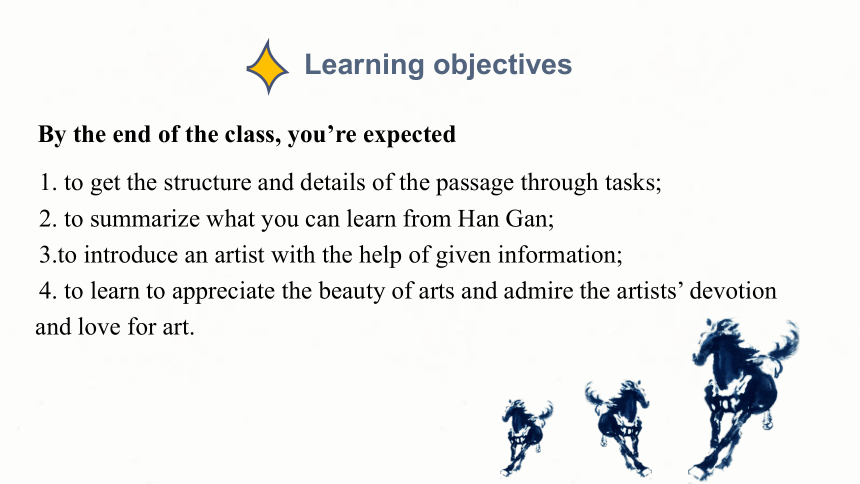

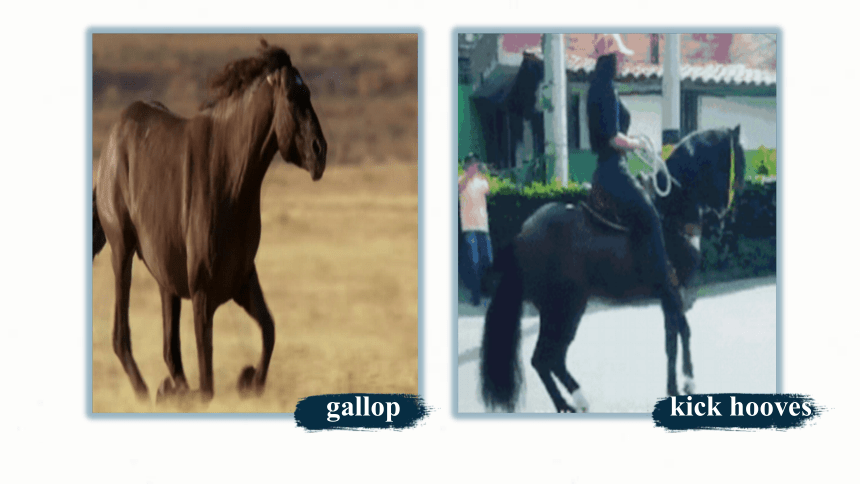
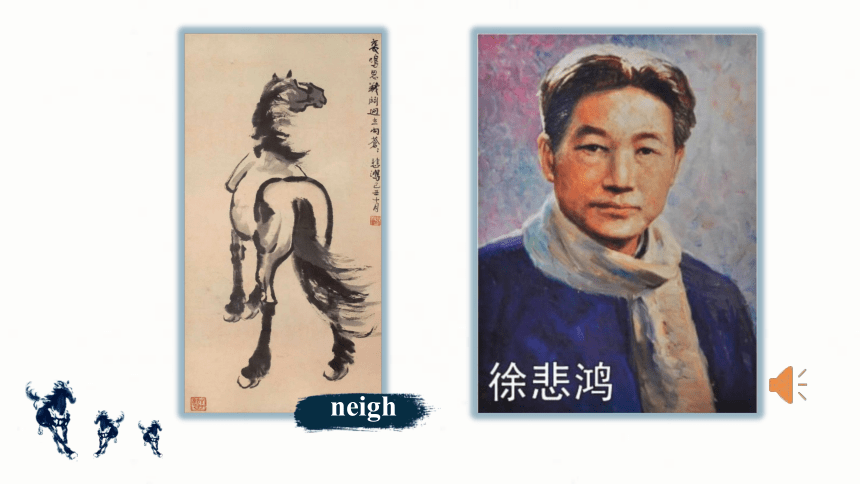
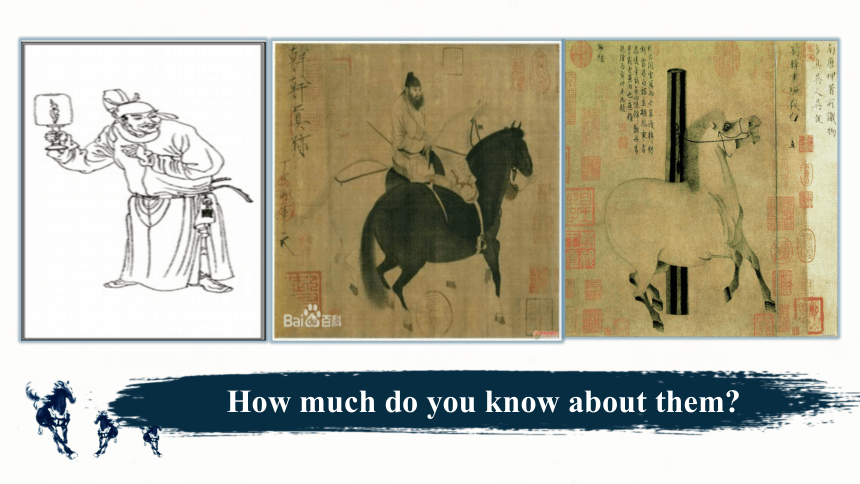
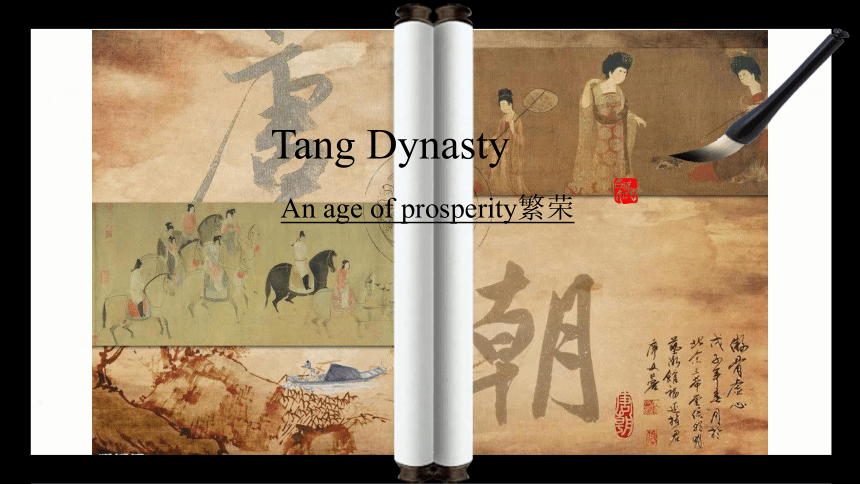
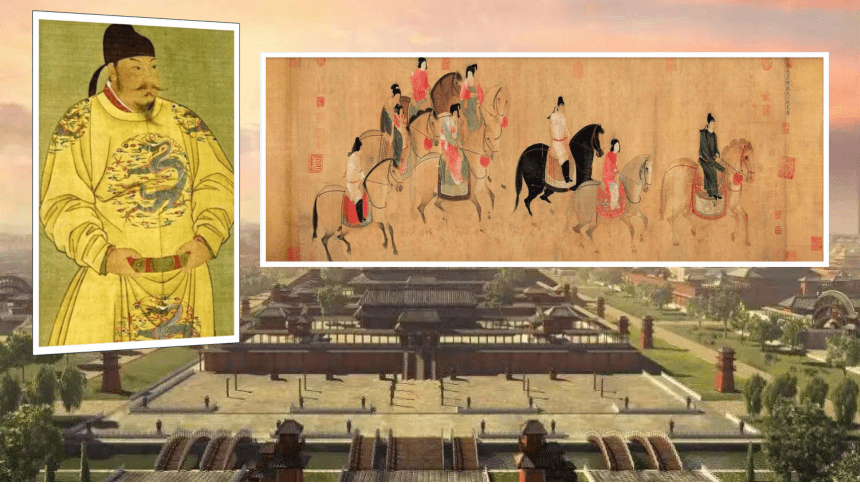
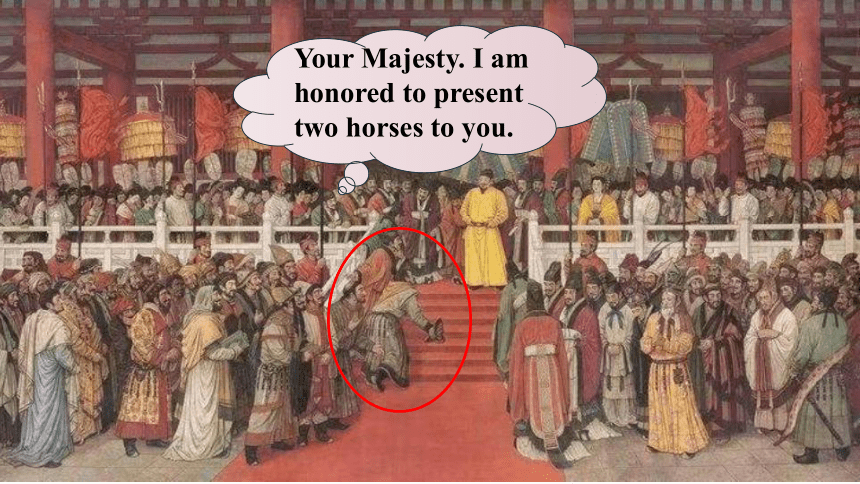
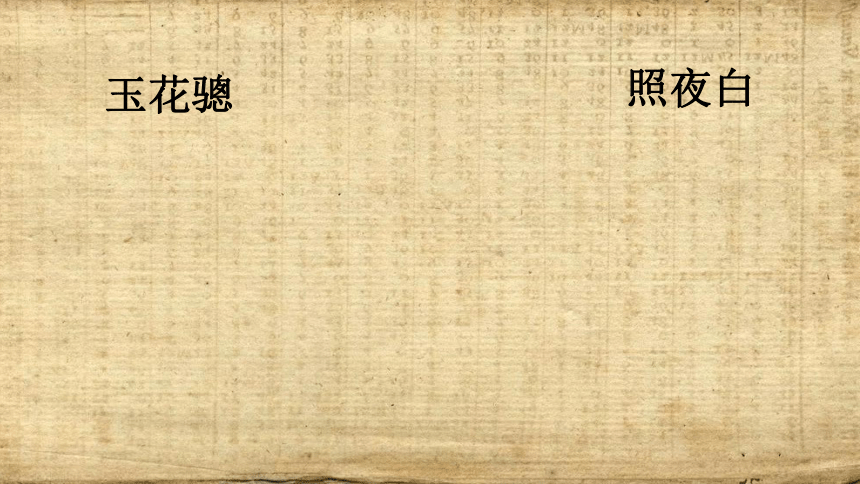

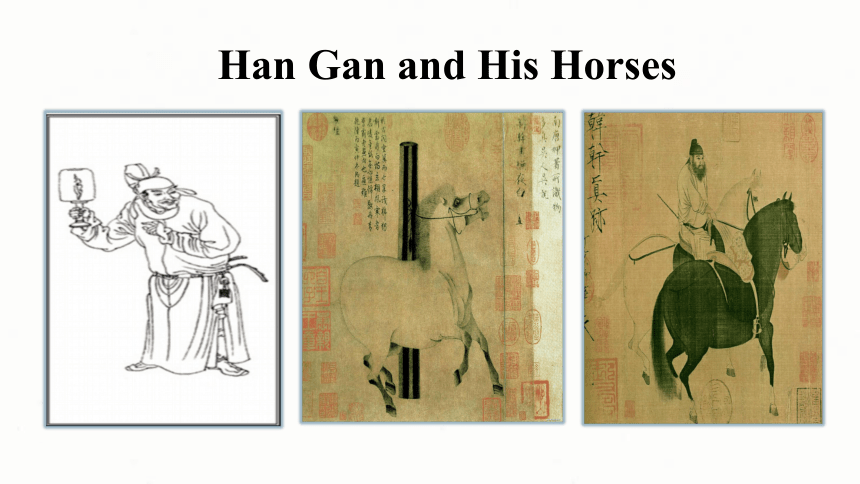
文档简介
(共41张PPT)
Unit 4 Amazing art
Developing ideas
By the end of the class, you’re expected
1. to get the structure and details of the passage through tasks;
2. to summarize what you can learn from Han Gan;
3.to introduce an artist with the help of given information;
4. to learn to appreciate the beauty of arts and admire the artists’ devotion and love for art.
Learning objectives
Guessing Game!
What’s the music about
gallop
kick hooves
neigh
How much do you know about them
Tang Dynasty
An age of prosperity繁荣
Your Majesty. I am honored to present two horses to you.
玉花骢
照夜白
Court Painter
Han Gan
Night-Shining White
Han Gan and His Horses
Read the passage quickly and find out what it is about.
A. An introduction to the Metropolitan Museum of Art.
B. The story behind Night-Shining White.
C. The famous artist Han Gan.
Read for structure
Which aspects should be included when we are introducing an artist
Han Gan
life
comments
masterpiece
Night-Shining White
Read for details
How is the horse described
What a magnificent horse!
burning eyes bared teeth kicking hooves
physical features
inner thoughts
Han Gan is known for his skill in capturing not only the physical features of the animal, but also its inner spirit and strength.
神奇韩干画,雄浑李陵诗!
--《笠翁对韵》
New York’s Metropolitan Museum of Art
纽约大都会艺术博物馆
Han Gan
life
comments
masterpiece
1. What a/an…!
2.Even after more than … years, we can still feel the power within…
Summary
How did Han Gan become an artist
Read for details
Born into...
be discovered by...
sponsor
serve Xuanzong
work in a...
Read for critical ideas
Do you agree Why
If Wang Wei hadn’t helped Han Gan, he would never have become an artist.
The harder you work , the luckier you will be.
birth& dynasty
became a painter
What else has been introduced about his life experience
Han Gan
life
comments
masterpiece
1. What a/an…!
2.Even after more than … years, we can still feel the power within…
Born into…
Due to…, he eventually…
Summary
birth& dynasty
became a painter
learned painting horses
Han Gan
life
comments
masterpiece
Born into…
Due to…, he eventually…
1. The more time he spent .., the more...
2. Day after day, Han Gan painted…,
3. It is said that…
1. What a/an…!
2.Even after more than … years, we can still feel the power within…
Summary
Sushi
Other viewers
Comments
The horses painted by Han Gan are real horses.
韩干马十四匹
苏轼 〔宋代〕
二马并驱攒八蹄,二马宛颈鬃尾齐。
一马任前双举后,一马却避长呜嘶。
老髯奚官奇且顾,前身作马通马语。
后有八匹饮且行,微流赴吻若有声。
前者既济出林鹤,后者欲涉鹤俯啄。
最后一匹马中龙,不嘶不动尾摇风。
韩生画马真是马,苏子作诗如见画。
世无伯乐亦无韩,此诗此画谁当看?
Read for details
The horses could gallop off the paper.
birth& dynasty
became a painter
learned painting horses
Han Gan
life
comments
masterpiece
Born into…
Due to…, he eventually…
1. The more time he spent .., the more...
2. Day after day, Han Gan painted…,
3. It is said that…
1. What a/an…!
2.Even after more than … years, we can still feel the power within…
Summary
Creative Activity
Role Play
Beginning: As a Guardian of National Treasure(国宝守护人), I want to introduce...
Body: *What dynasty he lived in
*Where he worked before becoming an artist
*Who discovered his talent in painting
*Which emperor he served
*What his masterpiece was and what the physical features of the horse in this painting (eyes, teeth, hooves...)
*How do other people like his painting skills (Su Shi, other viewers)
Ending: National treasures are essential part of our Chinese culture and they should be passed down from generation to generation. As a Guardian of National Treasure, I hope......
Writing
假设你是中国博物馆“文物回家”(Cultural-relic Returing)项目组的一名工作人员。 你给纽约大都会艺术博物馆的馆长写信,请他认真考虑,将中国画作——《照夜白图》归还给中国博物馆。
信的内容要求如下:
1.画作的作者是中国家喻户晓的著名画家,中国是他的家乡。该画作是非法流入海外,中国人盼望回归;
2.画作的内容、背景等信息,只有中国人才最懂,回到中国才最能体现它的艺术价值;
3.词数在120左右。
1. Night-Shining White, now kept in New York’s Metropolitan Museum of Art, is regarded as one of the most significant
horse paintings in the history of Chinese art.
现收藏于纽约大都会艺术博物馆,《照夜白图》 被认为是中国艺术史上最重要的骏马图之一。
Language points
Night-Shining White is a portrait, and the name, of a favorite horse of Emperor Xuanzong (r.712-756). The painting is 34 cm wide by 30.8 cm high. Delicate and precise, it is an example of “baihua”(or “white painting”), a term used in Tang texts to describe monochrome (黑白的) painting with ink shading, as opposed to full colour painting.
Over the years, many seals and inscriptions have been added to the painting and its borders by its owners. Being a distinctive mark of Chinese art collecting, these serve as a record of the work’s journey through history and the impression it has left upon each generation.
2. His artistic talent was discovered by accident when he was sent to the poet Wang Wei’s house to collect payment for some wine.
他被派到诗人王维家里去收酒钱,王维无意中发现了他的艺术才华。
by accident: by chance; in a way that is not planned or
intended 偶然,意外地
e.g. The basement caught fire by accident.
3. While waiting at the gate, Han Gan used a stick to draw pictures in the dirt and was seen by the poet himself.
当时,韩干在门口等候,他捡起一根木棒在土地上画画,正好被王维看到。
while引导省略的时间状语从句
poet的同位语
本句中,himself作了poet的同位语。第三段中也有一个反身代词作同位语,请找出来。
Han Gan’s method, however, was different— he observed the animal itself.
4. The Tang emperors were very fond of horses.
唐朝的皇帝非常喜欢马。
be fond of+ n./ v.–ing/ pron. 喜欢……,爱好……
e.g. She is fond of animals of all kinds, such as the dog and the cat.
I’m not very fond of cooking.
Over the years, I have grown quite fond of her.
5. Day after day, Han Gan painted the horses, his brush presenting every detail that he saw with his own eyes.
his brush presenting…是一个独立主格结构,his brush是现在分词presenting的逻辑主语。
句意:韩干日复一日地练习画马,用画笔把眼睛观察到的每一处细节都呈现出来。
时间状语
that引导的定语从句,修饰every detail
day after day: Continuously for a long time in a way that is
annoying or boring =day in day out 日复一日,天天地
e.g. I couldn’t stand sitting at a desk day after day.
我忍受不了日复一日地坐在办公桌前。
Day after day passed by without a line from him.
一天天过去了,没有他的一点消息。
day by day: slowly and gradually 天天,逐日,渐渐地
e.g. Her health was improving day by day.
【语境应用】选词填空(day after day/ day by day)
1) They plant trees _______________ and the trees are
growing taller _______________.
2) _______________, week after week and month after month, they worked on.
day after day
day by day
Day after day
6. All the horses in your stables are my very teachers.
您马厩里所有的马正是我的老师。
very used to emphasize that you are talking exactly about one particular thing or person adj. (用于加强语气)正是那一个的,正是的
e.g. Those were his very words. 那就是他的原话。
His life’s work was being destroyed before his very eyes (=directly in front of him) .
他毕生的成果就在他的眼前被人糟蹋。
7. Those who saw Han Gan’s horse paintings all sang high praises for his unique skill, saying that his horses “could gallop off the paper”.
句意:看过韩干的的骏马图的人都对他独特的技艺赞赏有加,称他的马“跃然纸上”。
who引导的定语从句
现在分词短语作状语
sing high praises for to speak very highly of something or someone; to enthusiastically endorse someone or something
高度赞扬
e.g. We all sing high praises for Zhong Nanshan, who makes great contributions to the treatment of the disease.
我们都高度赞扬钟南山,他为治疗这种疾病做出了巨大贡献。
同义表达
think highly of, speak highly of, have a high opinion of
【语境应用】一句多译。
他们对这部电影评价很高。
They sing high praises for the movie.
They think highly of the movie.
They have a high opinion of the movie.
Unit 4 Amazing art
Developing ideas
By the end of the class, you’re expected
1. to get the structure and details of the passage through tasks;
2. to summarize what you can learn from Han Gan;
3.to introduce an artist with the help of given information;
4. to learn to appreciate the beauty of arts and admire the artists’ devotion and love for art.
Learning objectives
Guessing Game!
What’s the music about
gallop
kick hooves
neigh
How much do you know about them
Tang Dynasty
An age of prosperity繁荣
Your Majesty. I am honored to present two horses to you.
玉花骢
照夜白
Court Painter
Han Gan
Night-Shining White
Han Gan and His Horses
Read the passage quickly and find out what it is about.
A. An introduction to the Metropolitan Museum of Art.
B. The story behind Night-Shining White.
C. The famous artist Han Gan.
Read for structure
Which aspects should be included when we are introducing an artist
Han Gan
life
comments
masterpiece
Night-Shining White
Read for details
How is the horse described
What a magnificent horse!
burning eyes bared teeth kicking hooves
physical features
inner thoughts
Han Gan is known for his skill in capturing not only the physical features of the animal, but also its inner spirit and strength.
神奇韩干画,雄浑李陵诗!
--《笠翁对韵》
New York’s Metropolitan Museum of Art
纽约大都会艺术博物馆
Han Gan
life
comments
masterpiece
1. What a/an…!
2.Even after more than … years, we can still feel the power within…
Summary
How did Han Gan become an artist
Read for details
Born into...
be discovered by...
sponsor
serve Xuanzong
work in a...
Read for critical ideas
Do you agree Why
If Wang Wei hadn’t helped Han Gan, he would never have become an artist.
The harder you work , the luckier you will be.
birth& dynasty
became a painter
What else has been introduced about his life experience
Han Gan
life
comments
masterpiece
1. What a/an…!
2.Even after more than … years, we can still feel the power within…
Born into…
Due to…, he eventually…
Summary
birth& dynasty
became a painter
learned painting horses
Han Gan
life
comments
masterpiece
Born into…
Due to…, he eventually…
1. The more time he spent .., the more...
2. Day after day, Han Gan painted…,
3. It is said that…
1. What a/an…!
2.Even after more than … years, we can still feel the power within…
Summary
Sushi
Other viewers
Comments
The horses painted by Han Gan are real horses.
韩干马十四匹
苏轼 〔宋代〕
二马并驱攒八蹄,二马宛颈鬃尾齐。
一马任前双举后,一马却避长呜嘶。
老髯奚官奇且顾,前身作马通马语。
后有八匹饮且行,微流赴吻若有声。
前者既济出林鹤,后者欲涉鹤俯啄。
最后一匹马中龙,不嘶不动尾摇风。
韩生画马真是马,苏子作诗如见画。
世无伯乐亦无韩,此诗此画谁当看?
Read for details
The horses could gallop off the paper.
birth& dynasty
became a painter
learned painting horses
Han Gan
life
comments
masterpiece
Born into…
Due to…, he eventually…
1. The more time he spent .., the more...
2. Day after day, Han Gan painted…,
3. It is said that…
1. What a/an…!
2.Even after more than … years, we can still feel the power within…
Summary
Creative Activity
Role Play
Beginning: As a Guardian of National Treasure(国宝守护人), I want to introduce...
Body: *What dynasty he lived in
*Where he worked before becoming an artist
*Who discovered his talent in painting
*Which emperor he served
*What his masterpiece was and what the physical features of the horse in this painting (eyes, teeth, hooves...)
*How do other people like his painting skills (Su Shi, other viewers)
Ending: National treasures are essential part of our Chinese culture and they should be passed down from generation to generation. As a Guardian of National Treasure, I hope......
Writing
假设你是中国博物馆“文物回家”(Cultural-relic Returing)项目组的一名工作人员。 你给纽约大都会艺术博物馆的馆长写信,请他认真考虑,将中国画作——《照夜白图》归还给中国博物馆。
信的内容要求如下:
1.画作的作者是中国家喻户晓的著名画家,中国是他的家乡。该画作是非法流入海外,中国人盼望回归;
2.画作的内容、背景等信息,只有中国人才最懂,回到中国才最能体现它的艺术价值;
3.词数在120左右。
1. Night-Shining White, now kept in New York’s Metropolitan Museum of Art, is regarded as one of the most significant
horse paintings in the history of Chinese art.
现收藏于纽约大都会艺术博物馆,《照夜白图》 被认为是中国艺术史上最重要的骏马图之一。
Language points
Night-Shining White is a portrait, and the name, of a favorite horse of Emperor Xuanzong (r.712-756). The painting is 34 cm wide by 30.8 cm high. Delicate and precise, it is an example of “baihua”(or “white painting”), a term used in Tang texts to describe monochrome (黑白的) painting with ink shading, as opposed to full colour painting.
Over the years, many seals and inscriptions have been added to the painting and its borders by its owners. Being a distinctive mark of Chinese art collecting, these serve as a record of the work’s journey through history and the impression it has left upon each generation.
2. His artistic talent was discovered by accident when he was sent to the poet Wang Wei’s house to collect payment for some wine.
他被派到诗人王维家里去收酒钱,王维无意中发现了他的艺术才华。
by accident: by chance; in a way that is not planned or
intended 偶然,意外地
e.g. The basement caught fire by accident.
3. While waiting at the gate, Han Gan used a stick to draw pictures in the dirt and was seen by the poet himself.
当时,韩干在门口等候,他捡起一根木棒在土地上画画,正好被王维看到。
while引导省略的时间状语从句
poet的同位语
本句中,himself作了poet的同位语。第三段中也有一个反身代词作同位语,请找出来。
Han Gan’s method, however, was different— he observed the animal itself.
4. The Tang emperors were very fond of horses.
唐朝的皇帝非常喜欢马。
be fond of+ n./ v.–ing/ pron. 喜欢……,爱好……
e.g. She is fond of animals of all kinds, such as the dog and the cat.
I’m not very fond of cooking.
Over the years, I have grown quite fond of her.
5. Day after day, Han Gan painted the horses, his brush presenting every detail that he saw with his own eyes.
his brush presenting…是一个独立主格结构,his brush是现在分词presenting的逻辑主语。
句意:韩干日复一日地练习画马,用画笔把眼睛观察到的每一处细节都呈现出来。
时间状语
that引导的定语从句,修饰every detail
day after day: Continuously for a long time in a way that is
annoying or boring =day in day out 日复一日,天天地
e.g. I couldn’t stand sitting at a desk day after day.
我忍受不了日复一日地坐在办公桌前。
Day after day passed by without a line from him.
一天天过去了,没有他的一点消息。
day by day: slowly and gradually 天天,逐日,渐渐地
e.g. Her health was improving day by day.
【语境应用】选词填空(day after day/ day by day)
1) They plant trees _______________ and the trees are
growing taller _______________.
2) _______________, week after week and month after month, they worked on.
day after day
day by day
Day after day
6. All the horses in your stables are my very teachers.
您马厩里所有的马正是我的老师。
very used to emphasize that you are talking exactly about one particular thing or person adj. (用于加强语气)正是那一个的,正是的
e.g. Those were his very words. 那就是他的原话。
His life’s work was being destroyed before his very eyes (=directly in front of him) .
他毕生的成果就在他的眼前被人糟蹋。
7. Those who saw Han Gan’s horse paintings all sang high praises for his unique skill, saying that his horses “could gallop off the paper”.
句意:看过韩干的的骏马图的人都对他独特的技艺赞赏有加,称他的马“跃然纸上”。
who引导的定语从句
现在分词短语作状语
sing high praises for to speak very highly of something or someone; to enthusiastically endorse someone or something
高度赞扬
e.g. We all sing high praises for Zhong Nanshan, who makes great contributions to the treatment of the disease.
我们都高度赞扬钟南山,他为治疗这种疾病做出了巨大贡献。
同义表达
think highly of, speak highly of, have a high opinion of
【语境应用】一句多译。
他们对这部电影评价很高。
They sing high praises for the movie.
They think highly of the movie.
They have a high opinion of the movie.
